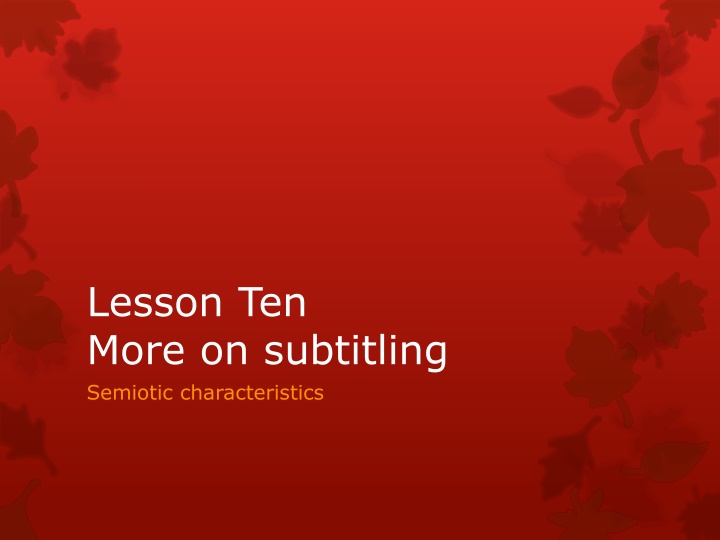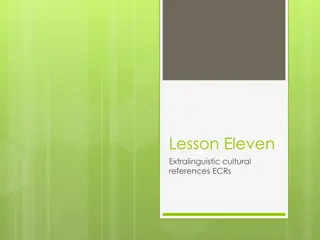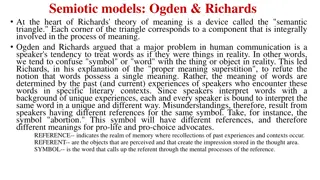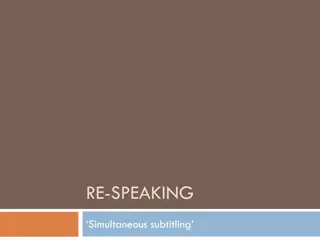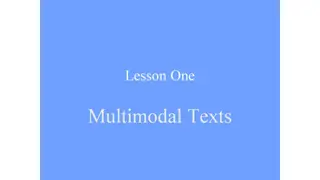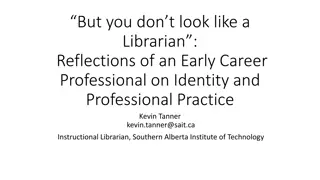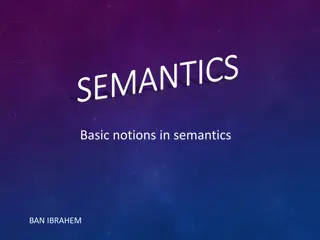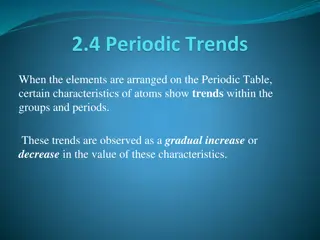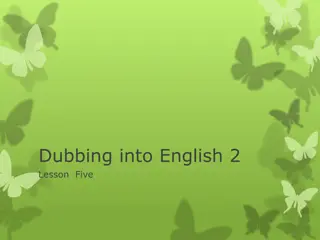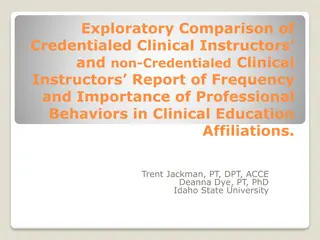Insights into Subtitling: Semiotic Characteristics and Professional Trends
Explore the world of subtitling through a discussion of semiotic characteristics such as diamesic translation and polysemiotic media. Learn about the evolution of subtitling in mainstream media and its preference over dubbing. Delve into the significance of physical support in polysemiotic texts and the unique challenges faced in translating for subtitling purposes.
Download Presentation

Please find below an Image/Link to download the presentation.
The content on the website is provided AS IS for your information and personal use only. It may not be sold, licensed, or shared on other websites without obtaining consent from the author.If you encounter any issues during the download, it is possible that the publisher has removed the file from their server.
You are allowed to download the files provided on this website for personal or commercial use, subject to the condition that they are used lawfully. All files are the property of their respective owners.
The content on the website is provided AS IS for your information and personal use only. It may not be sold, licensed, or shared on other websites without obtaining consent from the author.
E N D
Presentation Transcript
Lesson Ten More on subtitling Semiotic characteristics
Diamesic translation in polysemiotic media Subtitling can be defined (including films, TV, video and DVD) in the form of one or more lines of written text presented on the screen in sync with the original verbal content (Henrik Gottlieb)
diamesic translation the type of verbal transfer that crosses over from writing to speech, or as in the case of subtitling from speech to writing. This represents a break away from the semiotically loyal types of isomesic translation, in which the language mode of the original is retained: processes as diverse as conference interpreting, post synchronization (= dubbing) and literary translation.
polysemiotic The term refers to the fact that in film and TV productions, up to four semiotic channels are in operation simultaneously: two nonverbal channels (image plus music, & sound effects) and two verbal channels (dialogue, including narration and songs, plus written pictorial elements (eg. captions, signs, etc.)
Professional mainstream subtitling Most minor European speech communities have favored subtitling over dubbing and voice over ever since the introduction of sound film in the late 1920s. In prototypical subtitling countries, interlingual subtitles, costing less than 10% of lip sync dubbing, now constitute a major part of the reading matter. As a case in point, in 2010 the average Dane spent more than 39 minutes daily reading television subtitles out of a total viewing time of 201 minutes.
Zabalbeascoa, Chaume no text can be made entirely of verbal signs because such signs always need some sort of physical support Naturally, this physical support gains semantic momentum in genuinely polysemiotic texts. The most prominent polysemiotic text type is the audiovisual text. a semiotic construct comprising several signifying codes that operate simultaneously in the production of meaning
Translation for subtitling Synchronous subtitling constitutes a fundamental break with the semiotic structure of sound film by re introducing the translation mode of the silent movies, i.e. written signs. A question of co-occurrence not found in traditional translation.
Types of subtitle (a) subtitles created directly from the dialogue (foreign or domestic) and cued by the subtitler before broadcasting or cinema screening (referred to as bona fide subtitling and found mostly in public service TV and cinema)
Types of subtitle (b) b) subtitles based on existing pre cued subtitles in the source language or in another target language (referred to as relay subtitling and typically found in commercial TV and on DVD)
Type of subtitle (c) semi live subtitling, in which (TV) subtitles are created by the subtitler before broadcast and cued during transmission
Type of subtitle (d) live subtitling, where (TV) subtitles typically intralingual ones are created (sometimes using speech recognition technology) and cued, with a delay, during transmission.
Timing a) when each subtitle appears and disappears (in other words, the in and out cues), b) how long the individual subtitle stays on screen (i.e. the exposure time, or viewed differently, the reading time)
Bona fide subtitling The subtitler cuts up the running dialogue into subtitle blocks.
Cueing Finally, in the cueing phase the subtitler generates a specific set of time codes for each subtitle, ensuring that subtitle blocks are in sync with the shot changes and follow the rhythm of the original dialogue, and that subtitles are unobtrusive and easy to read.
However no two subtitlers are in sync, literally speaking. eg,. One Flew Over the Cuckoo s Nest subtitled by an American (intralingual) subtitler and by four professional Danish subtitlers: the in and out times of the five sets of subtitles differ (as hardly two subtitles start or stop at the same place on the horizontal time axis); the segmentation of the dialogue and the resulting number of subtitles also differ considerably, and obviously, far from all subtitles stand a chance of being in sync with the original dialogue. The differences in segmentation and cueing are even more pronounced if we move from the national to the international level.
Intralingual subtitling (1) Same language subtitling of foreign productions for language learners. (2) Same language subtitling of domestic productions for the Deaf and Hard of Hearing.
Type (2) for the deaf This type is now gaining ground in most of the world s industrialized nations, including the ones normally opposed to (interlingual) subtitling. In addition to its intralingual nature, type II subtitling typically contains elements of intersemiotic translation of plot carrying sound effects that cannot be guessed by hearing impaired viewers. In such instances, these nonverbal elements are rendered in writing, typically resulting in the insertion of bracketed subtitle lines as: (Waves washing ashore) or [crying].
Subtitling for the deaf and hard of hearing (HoH) target audience? Deaf: people who are deaf (completely) from birth; deaf: people who go deaf later in life through age or illness; HoH: people who are born with partial hearing impairment or lose some hearing ability. (slow readers, immigrants, etc.) (in translation those who know the foreign language and those who don t, etc. etc.)
Deaf culture Deafness is a clinical but also a sociological condition, a cultural issue. Culture, as I have stressed, is what is normal Katan (2004) or, if you prefer a system of congruent and interrelated beliefs, values, strategies and cognitive environments which guide the shared basis of behaviour (e.g. text production). The totally deaf live in a non-hearing culture where concepts such as pitch, rhythm, volume, etc. are, at best, vaguely understood. The HoH have a hearing culture as a reference point.
Different needs The above considerations call for the production of differing subtitles based on the requirements of each category of viewers; this has been the dilemma from the outset, as one version did not suit all users, and many users complained about the characteristics featured in the different media.
But, Jan Ivarsson even if the different requirements of the media and the types of audience concerned must be taken into account, some degree of harmonization can certainly be achieved, especially if state-of-the-art computer-based technology is used.
Subtitles Subtitles for the hearing population are often acceptable (e.g. in Slovenia), but subtitles prepared specifically for the deaf are increasingly used.
Intralingual Subtitling for the Deaf Franco and Santiago Ara jo (2003) conclude, following a pilot study on intralingual subtitling in Brazil, that 1. deaf subjects differ from hearing subjects in their requirements; 2. condensation and editing are crucial; 3. necessary orality markers and soundtrack noises must be integrated, requiring skilful condensing to not lose image-subtitle synchrony; 4. all should be checked with the help of deaf subjects;
Interlingual Subtitling for the Deaf: English to (Italian) An experiment: THE WEST WING (Episode 10) Two (and then three) Italian subtitled versions were prepared: > for hearing viewers (rapid and detailed) > for non-hearing viewers (slower and less detailed) > a harmonised version
Experiment Two groups of hearers: 1. Aged 52-85 (6 subjects) 2. Aged 22-27 (7 subjects) Both groups were asked to fill in a questionnaire and comment on such parameters as: presentation rate impact of shot changes positioning use of symbols etc. Modified after difficulties were encountered. It needed slowing , leading to the production of a first harmonised version i.e. a version that might possibly be acceptable for both hearing and non-hearing subjects.
SDH version An SDH version was also prepared, based on criteria from the limited literature on the subject and the results of the first experiment, for a group of 14 deaf subjects at the Trieste branch of the National Deaf Association. A quite wide age range but nobody under thirty. The same questionnaire was used as in the first experiment
SDH version In general, reception was better than in the hearing group. They prefer colour coding to symbols for character identification. Interestingly, their understanding of the subtitles (short and sharp, and connected to the visual) was greater that the understanding of the questionnaire.
Temporary conclusions It would seem that the carefully and specifically prepared SDH version succeeded with its audience more than the normal version for hearers even after its modifications. More fine tuning will be carried out on the harmonised version which will then be shown to deaf viewers. The SDH version will be shown to different groups of hearers ... until some kind of consensus is achieved. Watch this space.
this space The harmonised version was shown to deaf viewers. The group was comparable to the first experiment group in terms of numbers, age range, etc. There was a much more negative response and much lower comprehension, though the symbols were indicated as the major problem.
All the time, the language is changing The original text goes through continuous changes: original English > Italian translation > Italian adaptation for subtitles > harmonised version (s) > 1st experimental version for SDH > nth experimental version.
English to Italian ENGLISH What are you holding? Josh said you liked goldfish process transfer resignation ITALIAN SUBTITLE Cosa hai in mano? Josh ha detto che ti piacciono gli acquari. Quelli grandi! Quelli da visitare, Danny! The crackers, Danny The cheese things that you have at a party resignation resignation
Language change: harmonised to SDH 14. Il presidente star vicino all'albero Il presidente star qui mentre il coro qui a lato. 4 120 / 3 420 e il coro laggi . (Decimation) (Decimation/Condensation) 15. Con cappelli natalizi? Con cappelli natalizi? Costumi vittoriani. 3 080 / 3 480 Costumi vittoriani.
English The President will stand next to the tree with the flag on the left and the carolers will be off to the side. With the Santa hats on? Italian subtitles harmonised Il presidente star vicino all albero mentre il coro qui a lato. Italian SDH Il coro indosser costumi vittoriani Con cappelli natalizi? I cappelli natalizi starebbero male? Forse No. Dickensian costumes. Nice Maybe we ll have both. You think? You think they ll clash? Might Costumi vittoriani Magari entrambi. Starebbero male? Forse
1 English Indicative Declarative two clauses in paratactic relationship Ideational. Italian subtitles harmonised Indicative Declarative two clauses in paratactic relationship (2nd verb ellipted) Ideational. Indicative Interrogative minor clause Interpersonal Italian SDH Indicative Declarative (single clause covering 1 and 3) Ideational. Interrogative covering 2 7. 2 Indicative Interrogative - minor clause Interpersonal Modal adjunct negative polarity Interpersonal Declarative Ellipsis Appraisal Interpersonal Declarative Modality possibility Interpersonal Interrogative ellipted Interpersonal Interrogative ellipted. Interpersonal. Declarative ellipted. Modality possibilit Interpersonal 3 Declarative Ellipsis 4 5 Declarative minor clause Modality possibilit Interpersonal. Interrogative Interpersonal 6 7 8 Modal adjunct Interpersonal Modal adjunct Interpersonal
subtitling dialect into standard language . Straddling the fence between intra and interlingual subtitling A classic example of this is found in Danny Boyle s Trainspotting (1996), in which parts of the Edinburgh (Scottish) English were subtitled into standard British English. Cf Gomorra (Neapolitan to standard Italian)
Interlingual Subtitling Subtitling from a foreign language into the domestic majority language: Denmark, Sweden, Norway, Iceland, the Netherlands, Portugal, Estonia, Slovenia, Croatia, Romania, Greece, Cyprus, Argentina, Brazil, Egypt.
Bilingual subtitling (in cinemas) from a foreign language into two domestic languages: Finland (Finnish and Swedish), Belgium (Flemish and French), Switzerland (German and French), Israel (Hebrew and Arabic).
Minority languages Subtitling from national minority languages into the majority language: Ireland, Wales (English).
Immigrant language Subtitling from the majority language into an immigrant language: Israel (Russian).
Local varieties Subtitling from any local variety into the common written language: China (Mandarin).
Revoicing Revoicing foreign language dialogue in the favored language, with subtitles in a non favoured domestic language: Latvia (voice over in Latvian, subtitles in Russian).
Special cases Subtitling of foreign language dialogue in selected urban cinemas and, optionally, on DVD: France, Spain, Italy, Germany all still predominantly dubbing countries.
Attitudes to subtitling Attitudes differ greatly between speech communities in which reading subtitles is second nature to all segments of the population, and societies which see subtitling as something outlandish, often connected with the notion of art films.
A brief case study Get Shorty
Original dialogue Danish subtitles Back translation Ray Bones Barboni : Let me explain something to you. Momo is dead. Lad mig forklare: Momo er d d. Let me explain:Momo is dead. Which means that everything he had now belongs to Jimmy Cap, including you. Alt hans tilh rer nu Jimmy Capp. Dig inklusive. All this now belongs to Jimmy Cap. Including you.
E.g., from now on, you start showing me the proper fucking respect. Q.e.d. skal du fandeme vise mig respekt. Q.e.d. you fucking show me respect. Chili Palmer: E.g. means for example . What I think you want to say is i.e. . Barboni: Bullshit! It s short for ergo. Du mener dvs. . Q.e.d. betyder ergo. You mean i.e. Q.e.d. means ergo.
Barbonis bodyguard : To the best of my knowledge, e.g. means for example . Det betyder hvilket skulle bevises . It means which should be proven . Barboni: E.g., i.e. fuck you! The point is this: is that when I say jump , you say OK , okay? Pisseligegyldigt! . . . N r jeg siger hop! , s siger du okay! . Never fucking mind! When I say jump! , you say okay !.
Fansubbing Aldo, etc.
